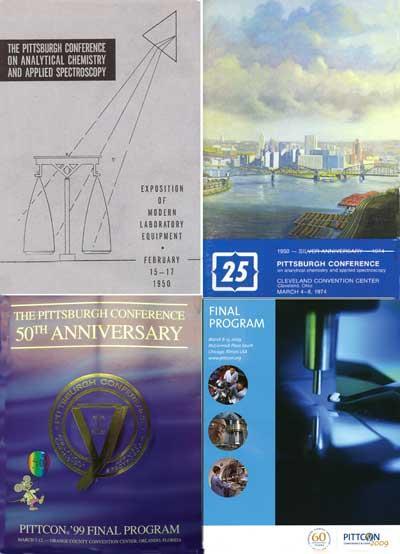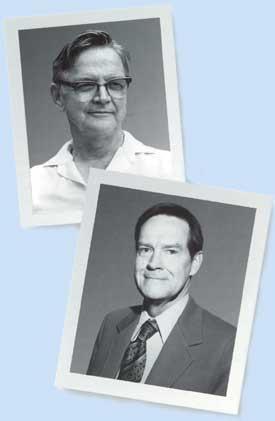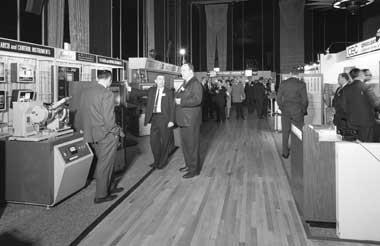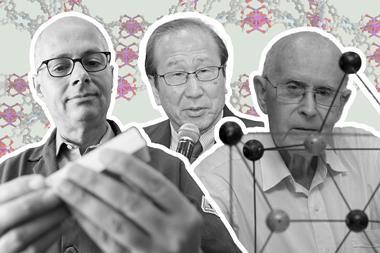The Pittsburgh Conference on Analytical Chemistry and Applied Spectroscopy celebrates its 60th birthday this year. Matt Wilkinson finds out how the show has evolved
The Pittsburgh Conference on Analytical Chemistry and Applied Spectroscopy celebrates its 60th birthday this year. Matt Wilkinson finds out how the show has evolved
Poised to enter its seventh decade, over the years Pittcon has seen more than 900 000 exhibitors and visitors walk through its doors. This year, the show - which combines an analytical chemistry conference with a major trade show attended by lab instrument makers large and small - celebrated its 60th birthday, with more than 1000 exhibitors registering. But in the age of digital communications, is the show tiring and edging towards retirement, or in peak condition and set to pass many more milestones yet?

Despite its name, the event is no longer held in Pittsburgh - for the simple reason that there is nowhere large enough in the city to hold the exhibition. In fact, there are just a handful of cities in the US with large enough conference centres - one of them being Chicago’s McCormick Place, this year’s host venue, with over 1 million square feet of exhibition space on a single floor.
Ed Ladner, this year’s show president and former head of spectrometry and microscopy at the US Department of Energy’s National Energy Technology Laboratory, believes that it is the personal interactions and the discussions sparked by new product launches and scientific programmes that traditionally have set the show apart. ’While this society [of chemists] relies on the immediate information provided by the internet, Pittcon provides a venue to talk to people working within the same discipline, learn about new techniques and find out about the latest product launches - I think you’re missing out if you don’t attend,’ says Ladner, who first attended as a volunteer in 1983.
Trade show attendance in general has been dropping since the mid-90s - when Pittcon hosted over 34 000 visitors - and many trade shows, such as the computer industry’s Comdex, have now disappeared altogether. This fall in attendance has been attributed to the rise of the internet and virtual trade shows, as well as falling travel budgets that are only likely to be squeezed further still during the global downturn.
’The world economic downturn is a major challenge to the show this year, we’d be foolish to think we’re not going to be impacted by it because our exhibitors and conferees are. We’re expecting to see a similar number of visiting companies as last year, but they may send less staff to man the booths,’ says Ladner.
’Many of our conferees will not have the budgets they used to and will have to make harder choices about which trade shows and conferences they go to - but I think that this is where Pittcon comes into its own. It’s more than just an exposition - it’s an educational experience,’ he continued.
It would seem that the 18 000-plus visitors at this year’s show agree with Ladner, and even if visitor numbers are down on the ’glory days’, the number still far outstrips the 800 that gathered for the first Pittcon in 1950.
A brief history of Pittcon
Located at the point where the Allegheny, Monongahela and Ohio rivers meet, Pittsburgh was the centre of a huge industrial heartland in the 1940s that pulsed with the flow of raw materials and manufactured products. The banks of the rivers bristled with steel mills, glass factories, foundries, oil companies as well as food and chemical producers. All needed testing and analysis laboratories to check their incoming and outgoing goods - and the scientists who manned these labs founded the Spectroscopy Society of Pittsburgh (SSP) and the Society for Analytical Chemists of Pittsburgh (SACP). The two societies merged their annual symposia in 1950, giving rise to the first Pittsburgh Conference on Analytical Chemistry and Applied Spectroscopy.

That first conference had 800 attendees and 14 exhibitors showing off the latest in laboratory equipment - the Fisher Scientific Company (now part of Thermo Fisher Scientific, one of the biggest exhibitors of the 2009 show) being one of them. The conference first moved outside of Pittsburgh in 1968 due to a strike by employees at the planned venue, the Penn-Sheraton Hotel, but the move to the Cleveland (Ohio) Convention Center proved so successful that the show stayed there for the next 11 years.
By the time the conference moved to Atlantic City in 1980 it was attracting nearly 16 000 attendees and 369 exhibiting companies, and visitor numbers past the 30 000 mark by 1987. In 1988 the Pittcon ’road show’ started, with the of conference changing host city almost every year, taking place in Atlanta, New York, Chicago and New Orleans. The Chicago conference in 1996 saw the most visitors ever - with 34 079 attendees and 1116 exhibitors making their way to the ’windy city’.
So what makes the show special? ’Pittcon is many things to many different people, and the breadth and depth of analytical science represented at the annual Pittcon meeting is simply unmatched,’ says Rohit Khanna, vice president of worldwide marketing for analytical instrument company Waters.
’Journalists and investment analysts are briefed on technologies that improve lab operations,’ Khanna continues. ’And for scientists and lab managers who are seeking methods and technology for food safety, environmental, fine chemical, pharmaceutical, and biopharmaceutical applications, Pittcon can’t be beat.’
Launch pad to the lab
Over the years Pittcon has become one of the key places to release new products and instruments, with many companies planning their product development cycles so that new instruments are released at the show.

’Because Pittcon is at the beginning of the year, in marketing terms it’s a perfect launch pad for new products and announcements, and the press conferences add that little bit of glamour to new product releases as they are attended by the international press,’ says Patricia Corkum, US marketing manager at analytical instrument maker Jeol - which also celebrates its 60th birthday this year.
Ian Jardine, vice president of global research and development for Thermo Fisher Scientific, agrees. ’We work hard to make sure we have a wide selection of new product introductions at the show,’ Jardine told Chemistry World . ’It’s a good time point because it’s early in the year and if we launch at Pittcon then we have the rest of the year to teach people how the products can help our customers,’ he adds.
Smaller, faster, smarter
While Pittcon has grown bigger, the instruments on display have become smaller, faster, more sensitive and easier to use. This has increased the usefulness of the instruments, and has seen them replace many traditional wet chemistry analysis methods. Where once Kjeldahl protein and oven moisture measurements were used to analyse wheat quality, near infrared (NIR) spectroscopy took over.
According to Gordon Wilkinson, founding editor of Analytical Instrument Industry Report , ’it is only in the last 25 or 30 years that instrumental techniques have largely replaced traditional wet chemical methods.

’The extraordinary developments in optics, detectors, computing and electronics have led to enormous advances in instrumentation. Fourier transform data-processing techniques have revolutionised infrared spectroscopy, Raman and NMR, while other mathematical techniques have done the same for X-ray diffraction and mass spectrometry - and these have only become routinely available to the bench chemist since the advent of the personal computer,’ he continued.
Most instruments are now computer-controlled, with user-friendly software enabling even the most inexperienced users to collect quality data. ’Overall the focus has definitely shifted to general use "open access" instruments that can be used by casual users rather than dedicated experts,’ says Douglas Meinhart, US vice president and analytical instruments director at Jeol.
’20 years ago the communication between instruments and computers was very rough and you would still see a lot of knobs and valves on instruments, but nowadays the instruments are pretty much "black boxes" that are computer-controlled. This has led to improvements in instrument performance and capability that would have been impossible without instrument control software,’ adds Jardine.
’One example of this is our LTQ Orbitrap ion trap mass spectrometer system, where the ability to control the RF [radio frequency] field that traps the ions on the microsecond scale is critical to instrument operation and this is only possible because of the instrument control software,’ he continues.
The other key development has been the increase in sensitivity, says Meinhart. And according to Charles Nielsen, SEM, EPMA and Auger instrumentation product director at Jeol, nowhere is the increasing sensitivity of techniques more apparent than in the electron-optics arena.
’The biggest challenge has always been to see the smallest possible thing in an SEM [scanning electron microscope] image,’ says Nielsen. ’When Pittcon started, SEMs were imaging at around 50nm, today they can get as low as 0.5nm - that’s a 100-fold improvement in resolution during the life of Pittcon.’
The same holds true for tunnelling electron microscopy (TEM) where the first microscopes in 1949 could image at 10nm, but the latest generation of microscopes can reach a resolution of 0.05nm - or a quarter of the diameter of a carbon atom.
And this increased sensitivity means a vast increase in the volume of data collected, requiring more advanced data analysis and storage software to be developed.
’A single experiment from an LC-MS/MS run using our high-end LTQ Orbitrap mass spectrometer can create gigabytes of data because every mass spectrum is over a high mass range, at a resolution of 100 000, which creates a vast number of data points with a mass accuracy to the parts per billion level - this all adds up to an incredible amount of data,’ says Jardine.
’The ability to analyse these data would be impossible without analysis software, which lets us identify thousands of peptides or proteins from just a single MS experiment,’ he adds.
The laboratory Oscars
Amongst all the hype of countless launches of state of the art instruments, trying to decide which products are most groundbreaking is difficult. The Pittcon Editors’ Awards programme for Best New Products on show at the conference was established by Gordon Wilkinson in 1996 to try to bring some clarity to the issue.

The awards represent the results of an informal poll of editors and journalists and have become an important feature of the show. One of the key challenges faced by the 150 or so media representatives that attend the show each year is to effectively cover the trade show to find the most interesting products launched. In 2008 that meant visiting 1110 exhibiting companies, and walking past every booth - representing a trek of over 10km.
The only criterion is that products must appear at the exhibition for the first time, and be available on the market. Gold, Silver and Bronze winners are determined and plaques are awarded to the booth personnel of the winning companies on the final morning of the four-day exposition.
’There is no better example of the importance of the show for Waters than the Acquity UPLC system that was launched in 2004. In the five years since its introduction, it has enjoyed an adoption rate that ranks the system as the most prolific new analytical technology in the past 25 years. And it all started when the Acquity system received the 2004 Pittcon Editors’ Gold Award,’ says Khanna.
In contrast, Jardine says he hasn’t seen a great correlation between the sales success of an instrument and whether it wins an award or not. ’Generally, if a new product is good it will sell well with or without an award. However, that doesn’t mean they are not important as they make the company and the development teams feel good about receiving an accolade,’ says Jardine.
Future-gazing
With the global recession cutting into company budgets and threatening to reduce visitor numbers still further, exhibitors were curious to see what the attendance would be like this year - and whether this year’s exhibitors would commit to the 2010 show.
Many exhibitors believe that changes need to be made to the format, with Meinhart - who has attended the show for over twenty years - suggesting that cutting the length of the show to three days would help reduce the costs to exhibitors.
’People have started to do a lot of research on the web before they attend the show so they can target which companies they want to visit and what types of instruments they want to see - rather than just wandering the aisles for days looking for things that catch their eye,’ says Meinhart.
These feelings are echoed by Jardine, who has been attending the show for even longer. ’People no longer just stroll around looking for things that interest them; they come to the show with a list of specific things they want to ask vendors. And those visitors no longer tend to be the laboratory workers - but instead are the lab managers that want to come to talk to companies and find out what those companies can do for them,’ says Jardine.
’Lab managers used to have to go to Pittcon every year as it was the only way to find out what was going on, but nowadays everybody goes to the web first and this is something that the organisers need to pay attention to.’

This shift is already having a measurable impact on the meeting. This year US instrument maker Varian pulled out of Pittcon, using the internet instead to host a ’webinar’, rather than participating as a booth exhibitor at the show.
Following Varian’s decision, rival firm Bruker announced that it too would not be attending the show next year. Bruker has called for the event to be held every second year, timed to alternate with Analytica, the biennial German laboratory show. Haydar Kustu, marketing manager for Bruker, said that from now on the company would be alternating its attendance between Pittcon and Analytica.
Other leading instrument makers also said they would be considering their options for next year very carefully, especially if the world economy had not started to recover by then. However, most said they would be reluctant to pull out of the show and miss out on the interaction with customers - instead they would prefer to take smaller booths to cut costs.
As Meinhart concludes, ’it’s not that Pittcon has become irrelevant - but the show needs to adapt to these changes.’






No comments yet